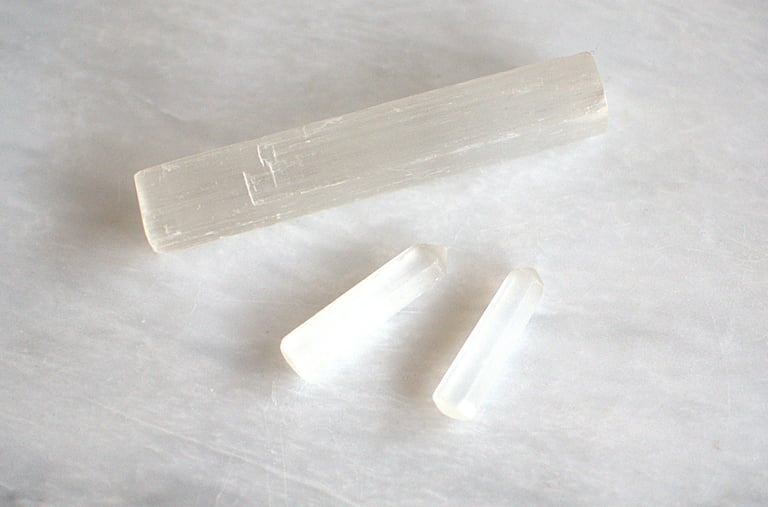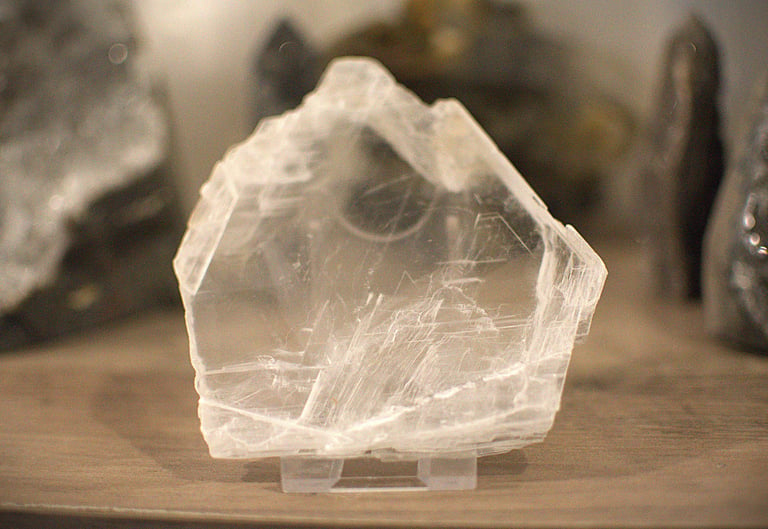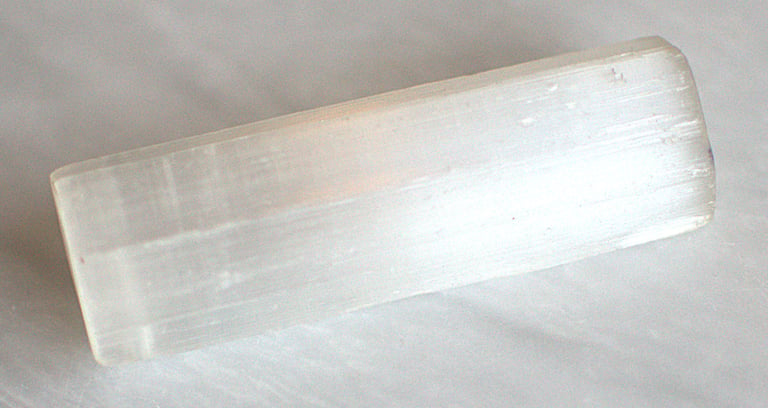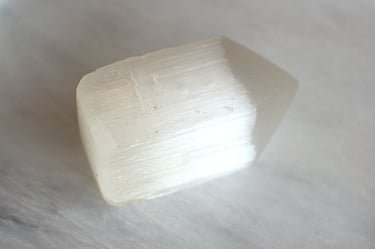Selenite
Purification, Clarity, Angelic Connection, Peace, Energy Clearing, Cleansing · Spiritual Connection, Higher Consciousness
Metaphysical Properties:
Selenite is renowned for its ability to cleanse and purify energy, both of people and spaces. It clears stagnant or negative energy, promotes mental clarity, and opens channels to higher guidance. It is often used to access angelic realms, enhance meditation, and support deep inner peace. Selenite is a stone of truth and honesty, helping reveal hidden patterns and encouraging alignment with one’s highest self.
Symbolism & Associations:
Selenite symbolises divine light, purity, and spiritual insight. Named after Selene, the Greek moon goddess, it is often linked with the celestial and the ethereal. Its translucent glow evokes calm, serenity, and a connection to higher realms.
Chakra Alignment:
Selenite primarily resonates with the crown chakra, clearing blockages and allowing divine light to flow through. It can also align all chakras simultaneously, acting as a conduit for spiritual harmony and energetic realignment.
Planets:
Moon
Zodiacs:
Cancer, Taurus
Elements:
Air, Spirit
Similar Stones:
Moonstone, Satin Spar, Angelite, Clear Quartz
Correspondences:
Colours: Translucent white, pearly silver, soft ivory.
Crystals: Moonstone, Clear Quartz, Apophyllite, Amethyst.
Flowers: White Lilies, Lotus, Baby’s Breath.
Herbs: White Sage, Mugwort, Myrrh.
Essential Oils: Frankincense, Myrrh, Lavender, Sandalwood.
Incense: Copal, Myrrh, Frankincense.
Metals: Silver, Platinum.
Months, Days, & Seasons: June, Monday, Winter




Facts
Stone Type:
A type of Gypsum called selenite, which is used to manufacture dry wall.
Hardness Rating:
2 on the Mohs scale – very soft and delicate. It can scratch easily and should not be submerged in water, as it is water-soluble.
Chemical Formula:
CaSO₄·2H₂O (Calcium Sulfate Dihydrate)
Care Guide
Selenite should not be exposed to water, oils, or perfumes. It is best stored separately to avoid scratches and handled gently. Due to its softness, it is not typically used in jewellery unless protected in a sealed setting.
Spiritual
Often used in meditation to clear the mind, connect with higher guidance, and invite peace into one’s energetic field. Selenite is a powerful stone for spiritual clarity and is believed to enhance the flow of divine light, intuition, and inner harmony in one's life.
Healing
Selenite is often used in energy healing to clear blockages, calm the nervous system, and promote energetic balance throughout the body. It’s believed to assist with stress relief, tension release, and mental clarity, making it a supportive tool for emotional wellbeing and spiritual alignment.
Cleansing
Selenite is self-cleansing and can be used to cleanse other stones. It is best recharged in moonlight or by placing it near clear quartz or on a selenite charging plate.
Affirmations
“I am surrounded by light and protected by divine energy.”
“Clarity flows through me with ease and grace.”
“I release all that no longer aligns with my highest good.”
“My spirit is connected, calm, and in perfect harmony.”
Meditation
Hold a selenite wand or place it on your crown during meditation to invite divine guidance and clear mental clutter. Visualise a beam of white light flowing through the crown, clearing and aligning all chakras as it moves through the body.
Astrology
Selenite’s connection to the Moon makes it especially potent during lunar events. It helps Cancers balance emotional flow and supports Taurus in releasing attachment to material concerns in favour of spiritual alignment.
Vibration
Selenite holds a high, refined vibration that is both calming and elevating. Its energy promotes clarity, peace, and spiritual connection, raising personal or environmental frequency. Often described as ethereal, Selenite helps attune one to higher realms and gently clears stagnant energy.
Did You Know:
Selenite can grow in massive crystal forms as tall as 12 metres, like those found in the Cave of the Crystals in Mexico. Despite being fragile, it is one of the most spiritually resilient stones, used worldwide for cleansing rituals.


Mythology & Folklore
Selenite’s name derives from the Greek goddess Selene, the embodiment of the Moon, who was said to drive her silver chariot across the night sky. This connection has given Selenite an enduring link to lunar energy, intuition, and feminine power. In ancient myth, Selene fell deeply in love with the mortal Endymion, whom she placed in eternal sleep so she could visit him each night. This tale is often used to explain Selenite’s association with tranquillity, dreams, and divine love.
Though Selenite itself was not always explicitly referenced in historical texts, many ancient civilisations valued transparent or luminous stones for their divine or mystical properties. In some interpretations, stones like Selenite were seen as frozen moonlight or solidified light, carrying celestial wisdom from the heavens to Earth.
In ancient Mesopotamia and Sumeria, gypsum (Selenite’s mineral family) was used in temple carvings and sacred architecture, believed to hold protective energy and spiritual clarity. In Egypt, luminous white stones were associated with purity, used in rituals to invoke Isis or Thoth—deities of wisdom, healing, and sacred knowledge. These connections reinforced the idea of Selenite as a bridge between earthly experience and divine understanding.
Selenite has also been linked with angelic communication in later esoteric traditions. In modern folklore and metaphysical practices, it is believed to be a favoured tool for connecting with guardian angels or ascended masters. The stone is often said to act as a spiritual antenna, enhancing messages from higher beings and helping practitioners translate subtle energies into conscious awareness.
As spiritual beliefs evolved, Selenite took on new mythologies rooted in the New Age and holistic healing movements. Its reputation as a stone of peace, purity, and energetic cleansing has grown globally, often seen as an essential crystal in modern spiritual toolkits.
Historical Significance
Historically, Selenite and its mineral relatives have been used for thousands of years in architecture, sculpture, and spiritual settings. The use of gypsum, Selenite’s broader mineral family, can be traced back to ancient Mesopotamia where it was employed in intricate carvings and construction, especially in sacred or ceremonial buildings. Due to its softness and translucency, it was often selected for decorative panels or statues that conveyed light, purity, or divinity.
In Ancient Rome, thin sheets of Selenite were used as window panes, valued for their transparency and ability to diffuse natural light while offering protection from the elements. These panels were especially popular in bathhouses, temples, and luxury villas. The use of translucent gypsum in this way continued through the Middle Ages, with Selenite windows still preserved in some old European cathedrals and chapels.
During the Renaissance and later into the Victorian era, naturalists and alchemists took new interest in translucent stones like Selenite for their energetic or medicinal qualities. It was studied and collected by those who believed in the influence of natural minerals on the human body and soul. These beliefs carried over into the metaphysical communities of the 19th and 20th centuries, where Selenite began to be seen as a tool for energy work, healing, and spiritual development.
In the modern era, Selenite has become a staple in crystal healing, meditation practices, and energy cleansing rituals. Its accessibility, affordability, and spiritual resonance have contributed to its widespread popularity. Found in crystal shops, wellness centres, and homes across the globe, Selenite is now considered essential in many spiritual practices for cleansing spaces, charging other crystals, and fostering inner clarity.
Origin & Formation
Selenite is a crystalline variety of the mineral gypsum (calcium sulfate dihydrate) and forms in evaporative sedimentary environments. It develops when water bodies such as lakes or seas rich in minerals begin to evaporate, leaving behind deposits of calcium and sulphate that eventually solidify into gypsum. When the crystallisation occurs slowly in undisturbed environments, large transparent Selenite crystals can form.
The most famous example of this natural process is the Naica Mine in Chihuahua, Mexico, home to the "Cave of the Crystals." Discovered in the year 2000, this cave contains some of the largest natural crystals ever found—giant pillars of Selenite measuring over 12 metres long and weighing more than 50 tonnes. These spectacular formations developed in extremely stable, mineral-rich conditions over hundreds of thousands of years.
Other significant deposits of Selenite are found in Morocco, Madagascar, the United States, Russia, Greece, and Australia. Each location can yield variations in clarity, size, and structure. Some forms are more transparent and glassy, while others are fibrous, pearly, or satin-like in appearance.
Despite its beauty, Selenite is very soft and water-soluble. It can easily scratch, flake, or dissolve if exposed to moisture. These traits make it unsuitable for many conventional uses, but highly valued for metaphysical applications where handling is gentle and purpose is energetic.
Selenite’s formation mirrors its energetic purpose—it emerges through the slow evaporation of excess, leaving only clarity and crystalline structure behind, much like its role in clearing away energetic clutter in human consciousness.
Variation & Quality
Selenite appears in several distinct forms, each with unique visual and energetic characteristics. The most well-known type is the common semi clear, glass-like variety pictured on this page, often shaped into wands, towers, or slabs. This form is prized for its high vibrational quality and is commonly used for charging other crystals, creating protective grids, or cleansing energy fields.
Peach or Orange Selenite, as illustrated in our photo below, is a naturally tinted variety of Selenite, coloured by trace minerals or iron oxide inclusions. It shares the same cleansing and high-vibrational properties as white Selenite but brings in additional grounding, nurturing, and emotional healing energy. This warm-toned variation is typically associated with the sacral chakra, promoting creativity, self-worth, and gentle transformation. Its soothing colour and energy make it a popular choice for emotional balance, self-love practices, and energetic protection during vulnerable times.
In energetic practices, Peach/Orange Selenite is especially effective for clearing blocked or stagnant energy in the emotional body, facilitating the release of old emotional wounds and trauma. It is frequently used in meditation to encourage self-compassion and forgiveness, helping individuals overcome guilt, shame, or unresolved grief. This stone's soft, comforting energy encourages openness to healing, making it a great ally in practices focused on heart and emotional healing.
When used in crystal grids, Peach/Orange Selenite is typically placed near the centre to amplify its nurturing effects, or around the outer edges to create a protective shield. Its gentle yet powerful energy enhances the work of other crystals, especially those related to emotional healing, love, and relationships. For this reason, it's commonly paired with stones like Rose Quartz, Rhodonite, or Moonstone in crystal layouts designed to foster inner peace and emotional stability.
Satin Spar is regularly sold as Selenite, but has a fibrous, silky appearance and a chatoyant sheen. While technically the same mineral, Satin Spar is opaque and reflects light in soft bands, similar to moonlight. It shares Selenite’s cleansing properties but is slightly more durable, making it ideal for decorative carvings and practical tools.
Desert Rose is another form of gypsum that regularly falls under the Selenite umbrella. It forms in rose-like clusters with petal-shaped crystal structures, often with a sandy or dusty coating. This form is known for grounding, protection, and anchoring spiritual energy into the physical world.
Gypsum Flower, a rarer and more fragile variation, consists of curved, lacy, flower-like formations that grow in arid caves or salt flats. These are delicate and ethereal in appearance, with a strong connection to elemental Earth and Water energies.
In terms of quality, Selenite is assessed based on clarity, structure, and finish. Clear slabs and wands with minimal inclusions are generally seen as higher grade. Hand-carved Selenite tools—such as bowls, plates, or palm stones—are also valued for their craftsmanship and spiritual utility.
Some Selenite may naturally exhibit internal striations, which are believed to act like energetic pathways that direct light and healing frequencies. Whether rough or polished, each piece holds a subtly different resonance depending on its formation, size, and intended use.
Notes
Selenite is sometimes confused with satin spar—both are gypsum but differ in appearance. Selenite tends to be clearer and more plate-like, while satin spar has a fibrous, silky look. Both share similar metaphysical properties.






